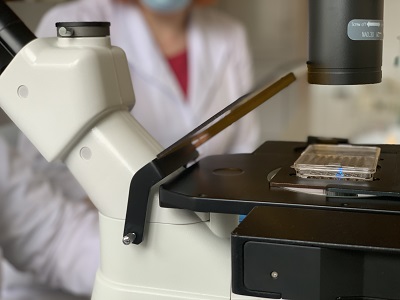Some of the key components of a microscope are the lighting to illuminate the specimen and the objectives to view the specimen. Depending on the type of microscope, these parts are either placed above the stage or below the stage. That’s where Inverted Vs Upright Microscope differ from each other. I will go deep into these microscopes covering their applications, design, differences, and what’s better.
With that being said, let’s look deeper into this subject by defining an inverted and upright microscope.
Inverted Vs Upright Microscope
Inverted and upright microscopes have the same working principle. A specimen is placed on a stage, light is focused on the specimen and the image is viewed through the objective lens.

The difference is in the placement of some parts in relation to the specimen.
Let’s start with the inverted microscope that was invented in 1850, that is more than one and a half centuries ago, by Lawrence Smith
In an inverted microscope, the condenser and the light source are placed above the object that is placed on the stage. The image is illuminated from the top. The microscope’s objectives are placed below the specimen facing up.
Why are they called Inverted Microscope?
This placement is the reverse of what you find on standard traditional microscopes, where the objectives are placed above the specimen, while the light source and condenser are found below the stage. The image is viewed from the top in a standard microscope.
Basically, on an Inverted Microscope:
- The light source and condenser are above the stage, where the specimen is placed.
- The objective lenses are below the stage facing upwards
- The stage is usually fixed
- Inverted microscopes have between 4 and 6 objective lenses. The lenses have different magnifications depending on the size.
There are basic and complex inverted microscopes. Some features you only find on advanced microscopes include:
- Support for video cameras
- Con-focal scanning
- Fluorescence illumination
There are Two Basic Types of Inverted Microscopes:
- Biological inverted microscopes
- Metallurgical inverted microscopes
Biological inverted microscopes are available with magnification from anywhere between 40x to 400x and sometimes to 1000x. The higher the magnification the higher the price. The high magnification makes this type ideal for observing living samples.
Unlike biological inverted microscopes, where the live specimen is placed in a petri dish, the specimen is prepared to lay flat on the stage in metallurgical inverted microscopes.
Some Uses of Inverted Microscopes
- To detect Phytophthora (plant-destroyer) species
- To examine the human pathogen mycobacterium tuberculosis parasite
- In the manipulation of cellular organelles (micromanipulation)
- In fungal culture tests
- To diagnose nematode infestations
Advantages of Inverted Microscopes

- Because the objectives are below the stage, they don’t come into contact with the specimen. This keeps the specimen sterile.
- When observing fluid samples most cells settle at the bottom. This makes for better observation since the objectives are located at the bottom.
- Inverted microscopes can be used to observe a large number of cells from the specimen. This is unlike when a specimen is placed between slides.
- Inverted microscopes can observe live and larger specimens than with upright microscopes.
- These microscopes have a wider stage. The specimen can be placed in a petri dish or glass tube.
- Inverted microscopes support differential interference contrast to create images with pseudo-3D-effect
- Inverted microscopes also support phase contact
- These microscopes also support a wide range of recording devices
Limitations of Inverted Microscopes
- Because of the complexity, inverted microscopes are pricier
- They are mostly reserved for the big laboratories.
Upright Microscopes
Let’s now analyze the upright microscope, which is the more common type of microscope.
The Most Common Types of Upright Microscopes are:
- Compound Microscopes
- Inverted Microscopes
- Metallurgical Microscopes
- Polarizing Microscopes
All these types have the following in common:
Unlike inverted microscopes where the objective lenses and the light source are placed below the stage, upright microscopes have the objective lenses and light situated above the stage, where the specimen is placed.
In upright microscopes, the specimen is illuminated from the bottom and observed from the top. The light travels through the sample which is mostly a slide. This is why most upright microscopes cannot be used to observe live specimens.
Despite this limitation, the upright microscope category consists of some of the most powerful microscopes. Some of the complex applications include:
- Hematology
- Microscopy
- NIR
- Histology
- Luminescence
- Veterinary
- Cytology
- Immunology
- Pathology
Advantages of Upright Microscopes
- Most of the microscopes found on the market are upright microscopes. As a buyer, you have a large pool to choose from. From simple monocular light microscopes to complex and highly-priced compound microscopes.
- Upright microscopes cost as low as a few hundred dollars up to thousands of dollars. This means you can get an upright microscope even on a budget, unlike most inverted microscopes whose starting price is significantly higher.
- There is an upright microscope almost for everything. This is unlike inverted microscopes which are only available in 2 types.
- They make some of the best microscopes for students.
- For school learning and teaching, there are ready-made slides for upright microscopes. If you have the technical know-how, you can prepare slides manually.
Limitations of Upright Microscope
- You cannot view live specimens on slides
- Preparation of slides is a complex process
Inverted Vs Upright Microscope | A Brief Comparison of these Microscopes
When it comes to power, upright microscopes and inverted microscopes are equally powerful. That’s why you will find both types in the most advanced and heavily equipped labs. The specific power and what the microscope can do depends on the specific model you have.
When it comes to design, upright microscopes and inverted are built differently. However, they have the same working principle and parts. The major difference between the two is the placement of the objective lenses and the light, in relation to the stage.
In an inverted microscope, the objectives are found below the stage while the light source is placed on top of the stage. This means the specimen is viewed from the bottom and illuminated from the top.
This makes this type of microscope great when observing specimens where the cells tend to settle at the bottom of the petri dish. Also, since inverted do not use slides, you can observe live specimens.

There is one area where upright microscopes are the clear winner; range. As you have seen above, most of the microscopes on the market are upright microscopes. The most basic ones are models designed for schools, while the most advanced are made for complex lab work. There are also premade slides for upright microscopes that you can buy. There is an upright microscope for everyone.
On the other hand, inverted microscopes are only available for use in the medical field. That’s why most of them are expensive as there are not as many options available as with the upright microscopes.
Inverted Vs Upright Microscope-In Conclusion
The major difference between upright microscopes and inverted microscopes is the placement of the light source and the objective lenses in relation to the stage. In upright microscopes, the image is observed from the top, while in inverted microscopes the image is observed from the bottom.
The choice between the two depends on your specific needs. If you will primarily be observing live specimens then go with an inverted microscope, while for slides the ideal option is the upright version.
